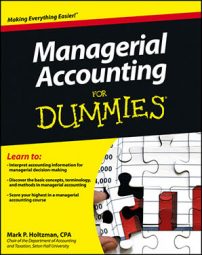To negotiate a transfer price between two divisions, lock the managers of the selling and purchasing divisions into a room and don’t let them out until they agree on a number or discover that no mutually beneficial price is possible.
Of course, these negotiations aren’t based on numbers the purchasing and selling divisions have pulled out of thin air. Each side has to do its research first. In order to prepare itself with a minimum transfer price, the selling division needs to carefully consider its cost structure and other sales opportunities.
Similarly, the purchasing division must figure out the maximum transfer price it’s willing to pay. The negotiated price winds up falling somewhere in the middle.
Find the selling division’s minimum transfer price
The selling division’s primary objective should be to add more money to its contribution margin, the difference between sales and variable cost. Therefore, as long as the selling division has excess capacity, it should be willing to sell its wares to the purchasing division for any value that will give it a contribution margin of zero or higher — a price that won’t hurt its profits.
The minimum transfer price should equal variable cost so that the selling division is willing to transfer goods to the purchasing division as long as the transfer price is equal to or exceeds this value.
Set the purchasing division’s maximum transfer price
Like the selling division, the purchasing division doesn’t want to lose money on any deal. Therefore, the purchasing division should be willing to pay any price that results in contribution margin greater than or equal to zero.
For example, Sandy’s sales price to customers is $10 per shirt. Because Sandy refuses to pay any variable cost that results in a negative contribution margin, she needs to figure out where to draw the line on price so that contribution margin equals zero:
Contribution margin per unit = Sales price per unit – Variable costs per unit
0 = $10 – Variable costs per unit
$10 = Variable costs per unit
Sandy can afford to pay no more than $10 in variable costs. Remember that she also must pay $1 commission for each T-shirt sold, a variable cost. Therefore, she has a maximum of $9 left to pay Jeffrey ($10 – $1). Therefore, the maximum transfer price that Sandy can afford comes to $9.
Note that this “purchase” price is so high that Sandy’s sales price only covers her variable costs, but not her fixed costs. Sandy certainly would prefer to pay a lower price so that her revenues cover both her variable and fixed costs.
Try to meet in the middle
At this point, the selling and purchasing departments are ready to sit down and talk. Both divisions play a role in setting prices that make each of them — and the company as a whole — profitable. For example, Jeffrey knows he can’t sell the T-shirts for any amount less than $5. Sandy won’t pay more than $9.
If the seller’s minimum price exceeds the purchaser’s maximum price, both parties agree not to cut a deal. After all, neither of them wants to lose money. What if Jeffrey’s minimum transfer price is $5 but Sandy’s maximum transfer price is only $3?
A sales price of $2 would make Sandy happy but force Jeffrey to lose $3 per shirt. A sales price of $7 would make Jeffrey happy but would cause Sandy to lose money. A compromise of $4 would force both divisions to lose money. They’d have to abandon the deal, a decision that would be in the best interest of the company as a whole.
Negotiated prices may be unduly affected by each party’s ability (or inability) to negotiate, causing divisions led by weak negotiators to earn less than divisions led by more-aggressive negotiators. Furthermore, clashing egos or lack of trust between negotiating partners can cause divisions to avoid transactions that would have been profitable for the company as a whole.
Manage with full capacity
If the selling division is operating at maximum capacity and has only a limited number of goods to sell, any goods sold to another division mean giving up sales to an outside customer. This scenario entails opportunity costs — the cost of losing profits because you choose a different alternative.
Therefore, the selling division’s minimum transfer price in this scenario equals its variable cost plus any contribution margin it would’ve earned from existing customers (that is, the opportunity cost of not selling to other customers).
Sylvia farms corn, and her business partner Herbert runs a restaurant. Corn costs $1 per ear to grow, and a sufficient demand exists, so Sylvia will have no problem selling her entire crop. Sylvia must choose whether to sell to her partner Herbert for his restaurant or to a local dealer. She can sell corn to the local dealer for $2 per ear as long as she pays additional variable sales commissions of $0.20 per ear.
Sylvia’s minimum price when negotiating with Herbert equals her variable cost plus the contribution margin she’d earn from existing customers. If she sells to the corn dealer, her contribution margin equals $0.80: $2 per ear less $1 variable cost to grow and $0.20 variable sales commission.
Therefore, her minimum transfer price for the deal with Herbert equals $1.80 ($1 cost plus $0.80 contribution margin earned from existing customers).

Selling to another division rather than selling to an outside customer can also affect variable costs. For example, suppose that fictional company Big Paper has two divisions: One manufactures raw paper, and the other makes paper bags out of raw paper. When selling to other divisions, the raw-paper division’s usual cost of $100/roll drops to $95/roll because of savings in shipping costs.
This savings in variable cost reduces the raw-paper division’s minimum transfer price by $5.
However, selling to another division may increase cost instead. Perhaps the internal purchasing division demands higher-quality materials than an outside customer would.

